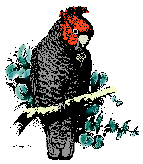|
Gang-gang breeding season is from October to late January - mid February. We don’t know the proportion of the Gang-gang population that breed, but we do know that small groups of non-breeding juveniles can flock together during this time. Spring counts organised
by Stacey Taylor, ACT Government ecologist, found that at that time the ACT population was too small to be accurately determined but estimated to be less than 150 individuals. However groups of 5-6 are not uncommon at any time of year. Gang-gangs also nest
close to other Gang-gangs and Mt Ainslie/Mt Majura is an important breeding area. Up till about December the male will spend most of the day on the nest, during this time you do get groups of nesting birds (predominately female or male if late in day early
in the morning) feeding together and also groups of non-breeding birds. In Autumn, post breeding, big numbers of Gangs-gangs can flock together- groups of up to 50 still regularly occur in some areas. So a group of 11 birds in Autumn in Canberra is not unexpected
- and this same group of birds may be seen by many. Adult and Juvenille females are difficult to tell apart, but young males can be expected to be more abundant than young females as in the Canberra area for every 10 males fledged there are only 7 females.
Sunflower seeds are the Macdonalds of the Gang-gang world, and caged birds fed largely on Sunflower seeds (which have a very high fat content) develop many illnesses some of which can be fatal. I have watched Gang-gangs in the Garran area fly
from one house proving Sunflower seed to the next and then on to the next. Thus Canberra household supplied sunflower seeds may provide a big part of the diet of our wild birds, and any individual feeding needs to be seen as adding to a wider threat. We have
recorded them feeding on over 300 plant and insect species and food availability is not an issue for them. It would be great if as many people as possible could refrain from feeding them - particularly Sun Flower seed. Local birds have alsohave been recorded
infected with Beak and feather disease so feeding particularly when feeding is with mixed parrot species can also aid the spread of this disease.
Cheers Michael Mulvaney
On 23 Mar 2025, at 5:36 pm, Sue Lashko via Canberrabirds <> wrote:
Dear Zac Flegg and Gail Neumann,
Over the past year or so we have been visited more and more often by local gang-gangs, and we have
occasionally fed them a few sunflower seeds on our back deck. (We often let them just take a drink, get bored waiting, and fly away.) For many months it seemed to be just two mates (male plus female) coming, but last December there seemed
to be a family of five or six in our nearby tree, recently we've had two or three arriving about twice a week, and yesterday we were suddenly visited by
11 gang-gangs, mostly young males we think. (I could send photos and videos.) Is this unusual, and should we discourage such mass visitation by not feeding any of them for some time?
Many thanks,
Jack Pezzey
Winnecke St, Ainslie (v. close to Mt Ainslie)
--
This is the email announcement and discussion list of the Canberra Ornithologists Group.
Emails posted to the list that exceed 2 MB (2,000 kB) in size, including attachments, will be rejected.
All emails distributed via the list are archived at
http://bioacoustics.cse.unsw.edu.au/archives/html/canberrabirds. It is a condition of list membership that you agree to your contributions being archived.
Canberrabirds mailing list
https://lists.canberrabirds.org.au/mailman/listinfo/canberrabirds
|

